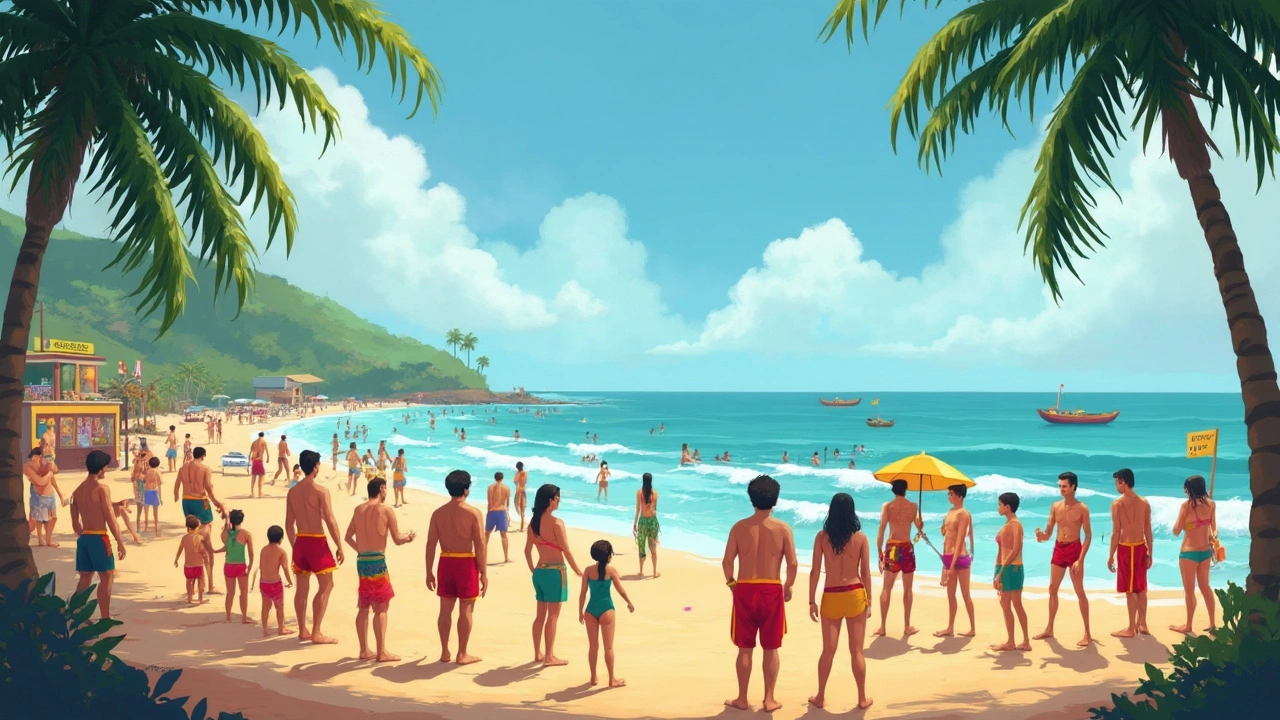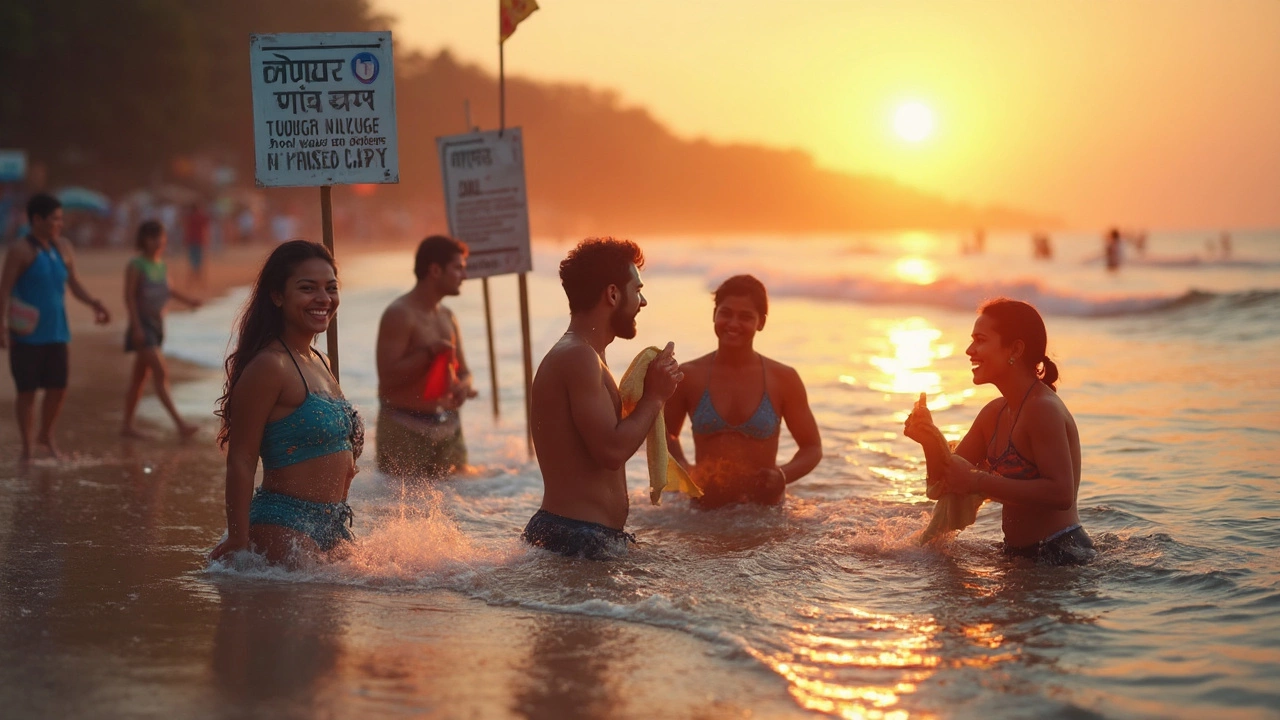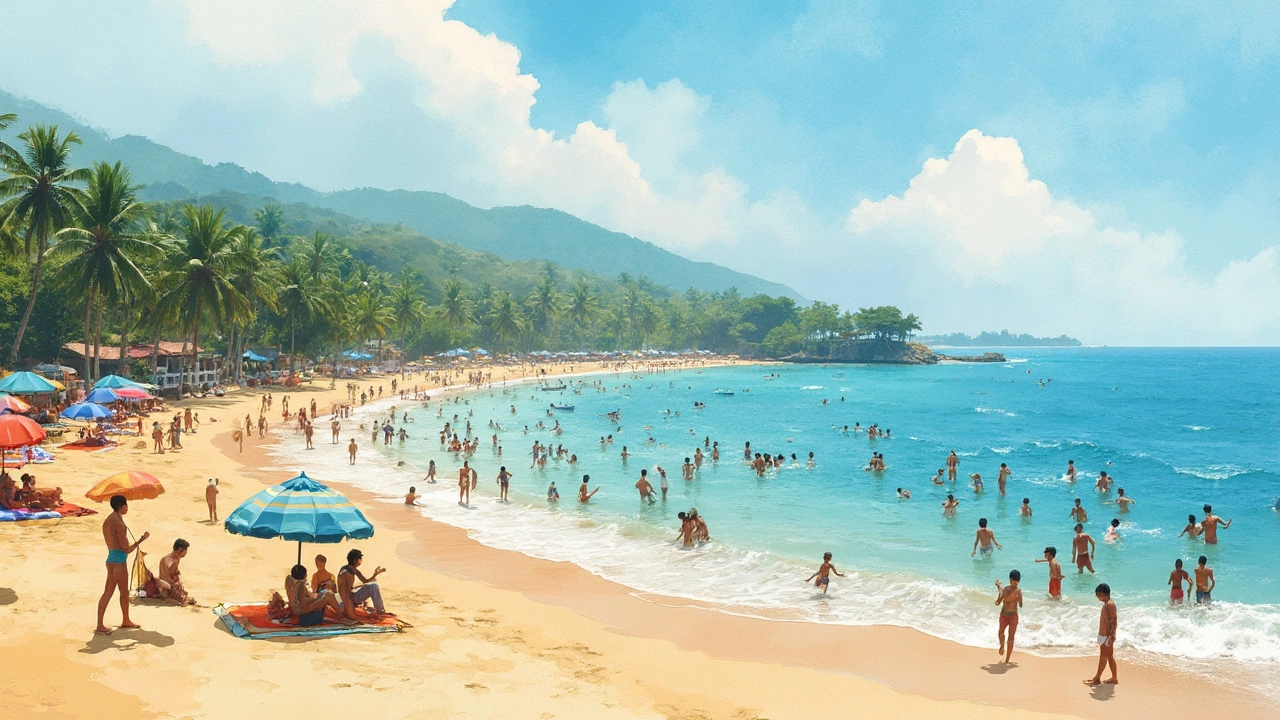Are Goa Beaches Safe and Swimmable? Guide to Swimming in Goa’s Best Beaches
 Jul, 2 2025
Jul, 2 2025
If you love the ocean but worry about strong currents or risky surf, Goa’s beaches have probably crossed your mind. So many Instagram stories flash those white sands and turquoise waves, but not everyone tells you whether the water’s actually swimmable. Everyone wants to avoid nasty surprises, whether it's a hidden undertow, unexpected jellyfish, or just endless crowds. Is Goa really that dreamy, or are some spots all for show? Time to shed some light on what’s really happening between the sand and sea.
What Makes Goa Special For Swimmers?
When it comes to swimming in India, Goa’s beaches top everyone’s wish list. It's not just about stunning sunsets or the coconut trees. What really stands out? The water temperature. Between November and February, the sea sits comfortably at 27-29°C—that’s perfect for a dip without the ice-cube effect. Plus, Goa doesn’t see those wild tidal shifts you might run into in other parts of Asia.
One thing that surprises newcomers: despite its position west-facing into the Arabian Sea, Goa isn’t constantly battered by rough surf. That means plenty of days when the water’s calm and inviting. There’s decent infrastructure, too: lifeguards, flagged swimming zones, and boards showing current conditions. But don’t let those positives lull you into complacency. While Goa’s laid-back image is legendary, the sea still deserves respect. Monsoon season from June to September brings dangerous rips, big waves, and floating debris—so much so lifeguards officially declare the sea off-limits for swimming then. Not worth pushing your luck.
For the rest of the year, over 30 major beaches dot Goa’s coastline. Many stay surprisingly clean compared to typical tourist spots in Southeast Asia, with regular clean-ups led by locals and volunteers. Places like Palolem, Benaulim, and Morjim go the extra mile, flying Blue Flags denoting environmental safety and water quality... and that’s a rare sight in India. Tourists and locals, families and adventure-seekers, all mingle across these sands to soak up that blend of sun, sand, and mostly tranquil seas. Yet not every beach delivers when it comes to safe waters. Knowing the difference could make or break your swim day.
Which Goa Beaches Are Safest For Swimming?
You’ve seen dreamy shots from Anjuna and Vagator, but you might be surprised by which beaches actually stack up as swimmable. Here’s where experience (and a few talks with lifeguards) pays off. Generally, South Goa’s beaches win out for safe swimming, mostly because they’re wide, gently sloping, and less overcrowded.
Best bets: Palolem is king if you like calm bays. The water shelfs gradually, few rocks lurk below, and there’s always a healthy crowd that makes things feel festive but not overwhelming. Benaulim and Colva follow close, with long stretches of flat, clean sand and plenty of space even at peak times. Lifeguards patrol daily and set up marked safe zones—just don’t ignore the flag system (red means dangerous, yellow means caution, green means OK, as most of the world knows).
Morjim stands out for both water quality and chill factor. This north Goa spot draws less of the hard-partying crowd, and the shallow surf means it’s a hit with families or nervous swimmers. Patnem is another gentle bay that rarely disappoints for relaxed, easy swimming.
Where should you think twice? Calangute and Baga might be famous, but they’re heavy on crowds and water sports traffic—dodging jet skis and banana boats isn’t the vibe you want. Anjuna, Vagator, and Arambol have patchier safety records too; the currents can change quickly near rocky outcrops, and there are fewer lifeguards.
| Beach | Swim Safety Level | Lifeguards Present | Water Quality | Best Time |
|---|---|---|---|---|
| Palolem | High | Yes | Excellent | Nov-Feb |
| Benaulim | High | Yes | Very Good | Nov-Mar |
| Morjim | High | Yes | Excellent | Nov-Mar |
| Calangute | Medium | Yes | Good | Nov-Mar |
| Anjuna | Low | Sometimes | Fair | Nov-Mar |
| Arambol | Low | Rarely | Fair | Dec-Feb |

Common Hazards: What Should Swimmers Watch Out For?
Let’s get honest—every paradise comes with a few catches. First up: the biggie is rip currents. Even experienced swimmers can get caught off guard here. Look for choppy water between sandbanks or places where the wave pattern doesn’t match the rest—that’s often where a rip is working. Lifeguards set out flags daily, so pay attention; reds and yellows mean they’ve spotted something risky.
Jellyfish don’t swarm every month, but from October to December, the odd Portuguese man o' war drifts close to shore, especially after storms. That’s an ouch you don’t want—raise a fuss immediately if stung and wash with seawater (not freshwater). Medical posts at busier beaches usually help out.
Water quality can dip after heavy rains (mainly just at the end or beginning of monsoon season), with run-offs carrying debris and a spike in bacteria, especially at popular beaches like Calangute or Baga. If the water isn’t clear or smells iffy, better to hang out in the shade.
Sunburn sneaks up fast—UV can be harsh, even when cloud cover rolls in. Reef-safe sunscreen, hats, and a habit of taking shade breaks save a lot of skin regret. Hydration's key too; the combo of salty dips and Goa’s humidity saps energy quickly. And don’t take valuables down to the sand; petty theft isn’t unheard of, especially at packed spots in high season.
One thing folks forget: drinking alcohol and hitting the waves is a terrible plan. Most serious incidents happen when swimmers have over-imbibed. Respect your limits, because the ocean won’t cut you slack.
Tips For a Smooth Swimming Experience in Goa
If you’re planning to swim your heart out in Goa, a bit of prep and local smarts goes a long way. Always check for beach notice boards—conditions change by the hour, especially during peak tides. Listen to lifeguards; these folks know their patch of ocean better than anyone.
Bring your own towel and water, because beachfront shacks can get pricey during tourist season. Try swimming early morning before crowds or water sports ramp up, and avoid late-afternoon dips during peak holiday weeks. Wear bright swimwear so you’re easy to spot from shore.
Never swim alone at quieter beaches, even if you think you’re Michael Phelps. At family beaches, designate an adult watcher while kids are in the water—Goa doesn’t always have lifeguards at every corner like Aussie or Kiwi coasts do. If you’re unsure about local water creatures (tiny crabs, the odd sea snake, or stingray), shuffle feet along the seabed rather than stomping.
For eco-minded swimmers, steer clear of disposable plastic—Goa’s cracking down hard on beach litter, so reusable water bottles and rubbish bags come in handy. If you want real peace of mind, stick to Blue Flag-certified beaches: they’re cleaned daily and monitored for quality.
If you get caught in a current? Don’t panic. Swim parallel to shore, not against the pull, and raise one hand for help. Most beaches with issues post rip tide maps, so check where they are before heading in.
- Spot flagged swimming zones—never swim outside them.
- Keep sandflies and mosquitos off with repellent after sunset.
- Ask locals about jellyfish or rough patches before taking a dip.
- Bring a change of clothes if you’re using shacks—some won’t let you inside wet.
- If you’re not confident in deep water, stick to shallows—Goa has plenty.

Best Time & Alternatives: When Goa Beaches Shine (and When To Skip Them)
Timing is everything. The best swimming season runs from late October to April, peaking between Christmas and February. By May, the currents pick up, jellyfish sneak closer, and the monsoon soon follows. If you’re heading for Goa in the off-season, consider a riverside guesthouse, or take a dip in one of the many hotel pools. Some luxury resorts have ocean-like saltwater pools where you can float without a care.
Festivals and holiday weeks bring wild crowds—especially at Baga, Calangute, and Candolim. If you want that castaway vibe, hit Palolem, Agonda, or Morjim at sunrise. Early birds pretty much own the sand from dawn till 9am.
Weather-wise, November and February are magic. You’ll dodge serious heat, avoid big rain dumps, and the water’s the right level of refreshing. Monsoon months (June–September) just aren’t safe, no matter how tempting the empty sands look. Lifeguards pull patrols and beach bars close. Trust their judgment—they know these waters better than any travel site can tell you.
Hate crowds? Go south, or try the quieter north Goa pockets. Fancy something different? Silent discos, yoga shacks, and paddleboarding in sheltered rivers offer swimming alternatives when the surf gets rough. For surfers, Goa’s no Bali or Raglan, but small smooth sets hit Ashwem and Mandrem pretty reliably in the dry season.
So are Goa beaches swimmable? Yes, but only if you pick your spot, watch out for risk signs, and pair that holiday spirit with a sprinkle of common sense. The sand, the sea, the breeze—they’re all waiting. Just jump in (carefully), and soak up some of India’s best shoreline.